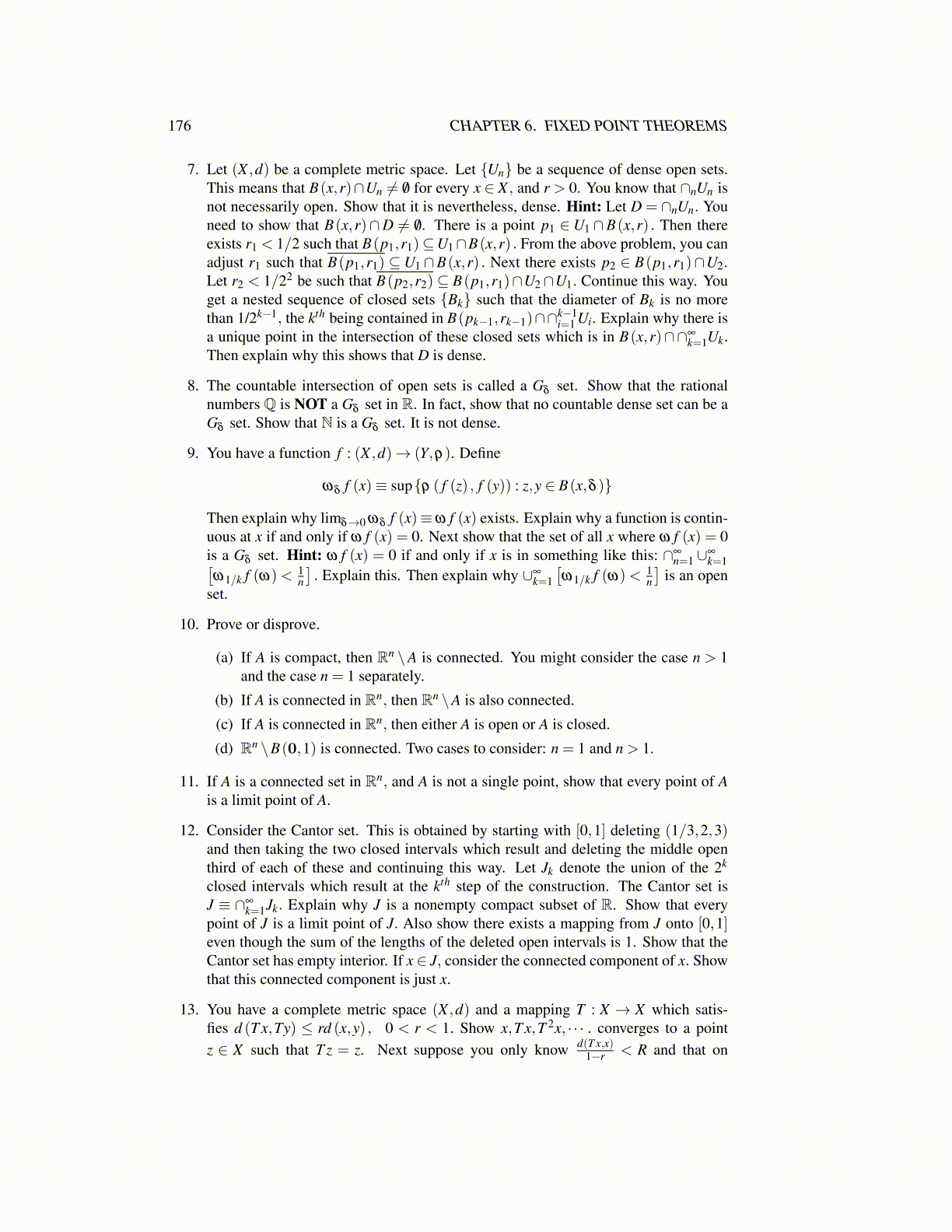
176 CHAPTER 6. FIXED POINT THEOREMS
7. Let (X ,d) be a complete metric space. Let {Un} be a sequence of dense open sets.This means that B(x,r)∩Un ̸= /0 for every x ∈ X , and r > 0. You know that ∩nUn isnot necessarily open. Show that it is nevertheless, dense. Hint: Let D = ∩nUn. Youneed to show that B(x,r)∩D ̸= /0. There is a point p1 ∈ U1 ∩B(x,r) . Then thereexists r1 < 1/2 such that B(p1,r1)⊆U1∩B(x,r) . From the above problem, you canadjust r1 such that B(p1,r1) ⊆U1 ∩B(x,r) . Next there exists p2 ∈ B(p1,r1)∩U2.Let r2 < 1/22 be such that B(p2,r2)⊆ B(p1,r1)∩U2∩U1. Continue this way. Youget a nested sequence of closed sets {Bk} such that the diameter of Bk is no morethan 1/2k−1, the kth being contained in B(pk−1,rk−1)∩∩k−1
i=1 Ui. Explain why there isa unique point in the intersection of these closed sets which is in B(x,r)∩∩∞
k=1Uk.Then explain why this shows that D is dense.
8. The countable intersection of open sets is called a Gδ set. Show that the rationalnumbers Q is NOT a Gδ set in R. In fact, show that no countable dense set can be aGδ set. Show that N is a Gδ set. It is not dense.
9. You have a function f : (X ,d)→ (Y,ρ). Define
ωδ f (x)≡ sup{ρ ( f (z) , f (y)) : z,y ∈ B(x,δ )}
Then explain why limδ→0 ωδ f (x)≡ω f (x) exists. Explain why a function is contin-uous at x if and only if ω f (x) = 0. Next show that the set of all x where ω f (x) = 0is a Gδ set. Hint: ω f (x) = 0 if and only if x is in something like this: ∩∞
n=1 ∪∞k=1[
ω1/k f (ω)< 1n
]. Explain this. Then explain why ∪∞
k=1
[ω1/k f (ω)< 1
n
]is an open
set.
10. Prove or disprove.
(a) If A is compact, then Rn \A is connected. You might consider the case n > 1and the case n = 1 separately.
(b) If A is connected in Rn, then Rn \A is also connected.
(c) If A is connected in Rn, then either A is open or A is closed.
(d) Rn \B(0,1) is connected. Two cases to consider: n = 1 and n > 1.
11. If A is a connected set in Rn, and A is not a single point, show that every point of Ais a limit point of A.
12. Consider the Cantor set. This is obtained by starting with [0,1] deleting (1/3,2,3)and then taking the two closed intervals which result and deleting the middle openthird of each of these and continuing this way. Let Jk denote the union of the 2k
closed intervals which result at the kth step of the construction. The Cantor set isJ ≡ ∩∞
k=1Jk. Explain why J is a nonempty compact subset of R. Show that everypoint of J is a limit point of J. Also show there exists a mapping from J onto [0,1]even though the sum of the lengths of the deleted open intervals is 1. Show that theCantor set has empty interior. If x ∈ J, consider the connected component of x. Showthat this connected component is just x.
13. You have a complete metric space (X ,d) and a mapping T : X → X which satis-fies d (T x,Ty) ≤ rd (x,y) , 0 < r < 1. Show x,T x,T 2x, · · · . converges to a pointz ∈ X such that T z = z. Next suppose you only know d(T x,x)
1−r < R and that on